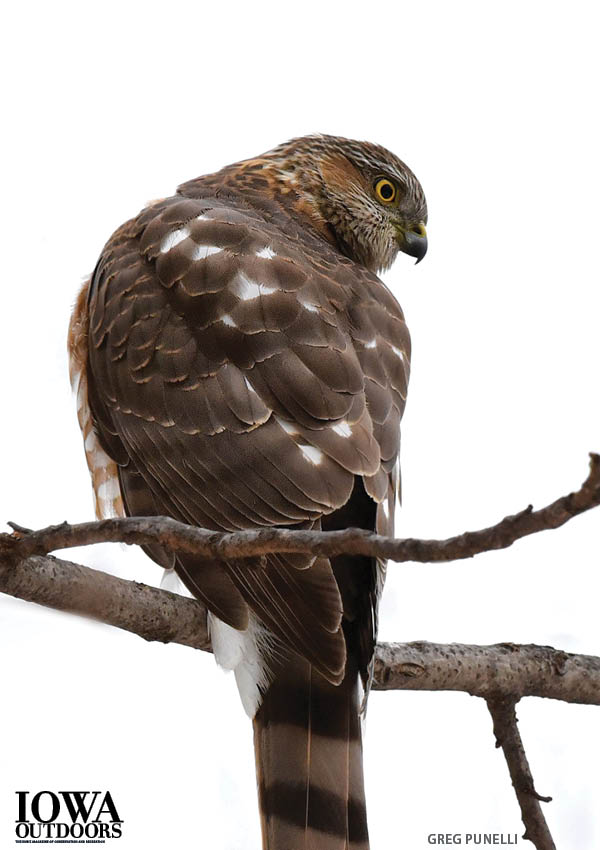From "Flora & Fauna" in the March/April 2017 issue of Iowa Outdoors magazine
Subscribe now
Cooper’s hawks (Accipiter cooperii) are one of Iowa’s three accipiter species. (Accipiter is Latin for hawk and these species are primarily woodland raptors.) The Cooper’s hawk primarily dines on other birds. It’s the most widespread accipiter on the continent, with a range at least seasonally stretching from Panama to the southern tier of Canadian provinces.
 Body Double
Body Double
Cooper’s hawks are nearly identical to sharp-shinned hawks. Even experienced birders waffle on identifying them at a glance. Adults of both are primarily blue-gray from the back with rufous barring underneath and red eyes. In flight, Cooper’s tails are more rounded than sharpshinned hawks, and Cooper’s hawks’ heads appear larger.
When perched, look for the Cooper’s blocky head, or the dark beret-type marking on their heads—they have a lighter section at the nape of their necks that sharp-shinneds lack.Juveniles of both have similar plumage patterns, but Cooper’s belly markings are darker and their tails are more barred.
Aerial Ambush
To catch small- to medium-sized birds, Cooper’s hawks perch and wait or prowl forest edges. Relatively long tails and short wings allow them to dodge tree trunks and limbs during chase, but careening through forests at nearly 60 mph is risky business. A study of 300-plus hawk skeletons, found 23 percent with healed chest fractures, presumably from flying into trees.
Compression Kill
Cooper’s hawks can’t dispatch prey quickly because they lack a beak notch, or tomial tooth, to separate prey’s vertebrae. Instead, they squeeze prey in their sharp talons, or hold prey underwater until it drowns. They eat about 12 percent of their weight daily to sustain their high metabolic demands. Preferring meals of pigeons, robins, doves and jays, they also small rodents like chipmunks—even amphibians, fish or small reptiles. They frequent bird feeders for an easy catch and will chase ground-dwelling mammals on foot. Adapting well to urban life, they dart between buildings to take pigeons and doves. (Nestlings can contract parasitic diseases from too much dove in their diet.)
Early Trials Against Mortality
After hatching, nestlings face the most perilous year of their life. Despite seven weeks of parental care, they may be eaten by a variety of predators (including other Cooper’s hawks). They may fall from the nest or starve to death if they cannot quickly learn to fend for themselves. Like many raptors, 70 to 80 percent perish before reaching adulthood and sexual maturity at 2 years old.
Luck Be a Lady
Males have a dangerous breeding season as approaching a female could get them eaten. (Females are a third larger than males.) To attract a mate, males display submissive behavior—flying in large, slow arcs until his love interest calls out reassurance before coming closer. Males construct a 2-foot wide, 8-inch deep nest. The pair are monogamous for the season. Females lay two to six eggs and spend 30 days incubating as the male hunts.
No DDT for Me
Numbers plummeted in the mid-1900s due to DDT. This toxic pesticide caused abnormally thin egg shells—likely to break under the weight of incubating females.
For more, check out our Iowa Wildlife and Iowa Outdoors Magazine boards on Pinterest.